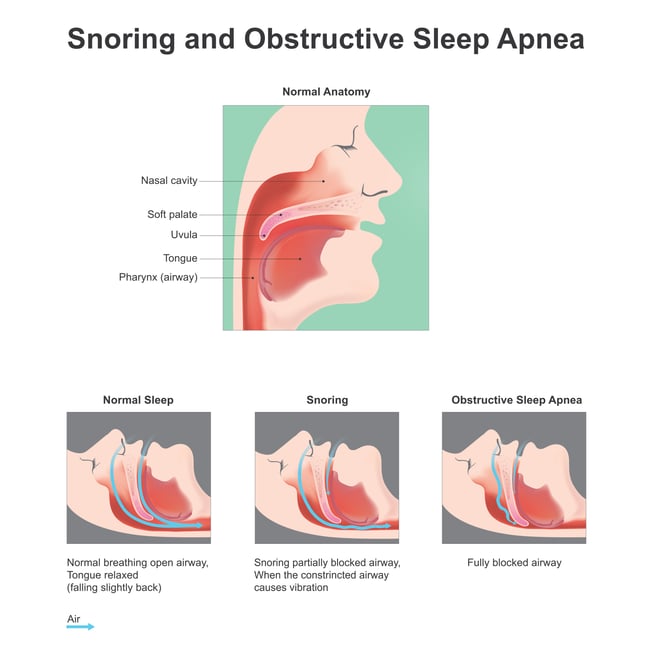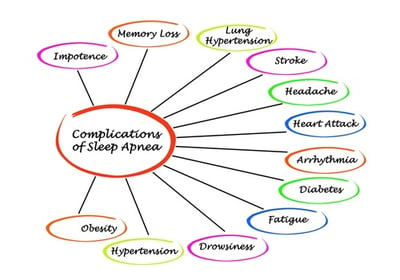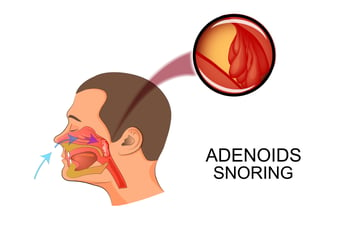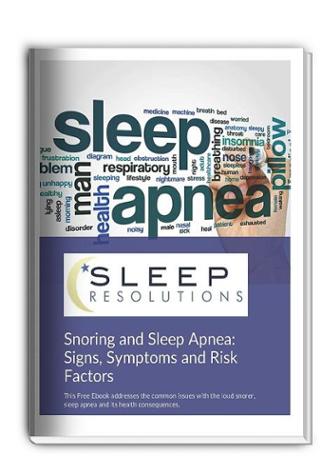.jpg?width=700&name=shutterstock_537564736%20(1).jpg) Snoring and obstructive sleep apnea (OSA) can be independent physical conditions, and they can also be related. The relationship depends upon the causes and severity of the snoring.
Snoring and obstructive sleep apnea (OSA) can be independent physical conditions, and they can also be related. The relationship depends upon the causes and severity of the snoring.
Snoring is prevalent in our culture. Approximately 90 million American adults snore. Of that number, 37 million snore on a regular basis. While about half of all snorers are primary snorers or “simple snorers”, about one-half of the people who snore loudly have OSA.
OSA is also prevalent. About 24 percent of men and 9 percent of women, which equates to about 18 million American adults, suffer from some degree of obstructive sleep apnea.
What is snoring?
Snoring is noisy breathing that occurs when the tissues in the person’s mouth, their tongue, and airway muscles relax upon sleep. The tissues collapse into the airway partially obstructing the airway. As a result, the throat becomes narrow. The snore sound is caused by the vibration of the throat walls that occurs when the air entering the throat passes the obstructing tissue. The more restricted and narrow the airway, the louder the snoring will be.
Primary snoring (also known as simple snoring) is basically the sound that occurs when the person is sleeping. It can disrupt the sleeper’s sleep as well as the bed partner’s sleep.
Snoring can rob a person of restful sleep due to the arousals and fragmented sleep that occur from light sleep, disrupted sleep and the bed partner jabbing their elbow into your side all night. This fragmented sleep causes daytime fatigue and excessive daytime sleepiness.
There may be morning headaches from a lack of oxygen during the night. High blood pressure and heart disease have also been linked to snoring in those who do not have OSA. So finding appropriate treatment for snoring is important for your overall health, as well as your bed partner’s.
 What is OSA?
What is OSA?
Sleep apnea occurs when the tissues in the airway obstructs 90 percent or more of the airway. The airway is almost completely or totally obstructed, and air cannot get into the lungs. A person will not be able to breathe during an apnea. When the brain receives the emergency message "oxygen needed", the brain will arouse, and the person will take a breath, sometimes making a snorting or gasping sound.
Loud, frequent snoring is usually a symptom of OSA, but not always. A person can snore and not have sleep apnea. On the other hand, a person can have OSA and not snore. The differences lie in the causes of OSA and the snoring.
Causes of OSA
Obstructive sleep apnea is caused from the airway collapsing completely during sleep. This prevents air from getting into the lungs. As a result, a lack of oxygen called hypoxemia results, causing a fight or flight response from the brain and body. The more often apneas occur during the night, the more severe the apnea and the more adversely affected a person’s health will be.
 OSA has been associated with numerous health conditions, including heart disease, stroke, high blood pressure, depression, accidents, poor school/work performance, excessive daytime sleepiness, obesity, diabetes, memory loss, arrhythmias, cancer, and death.
OSA has been associated with numerous health conditions, including heart disease, stroke, high blood pressure, depression, accidents, poor school/work performance, excessive daytime sleepiness, obesity, diabetes, memory loss, arrhythmias, cancer, and death.
Hypoxemia causes a cascade of stress responses in the body that affects almost every organ in the body. OSA has also been linked to the majority of the top 10 causes of death.
Causes of snoring
The causes of snoring are varied and dependent upon the person.
As we age, our muscles become more lax, losing their tone. This tonal loss occurs in the airway tissues as well as in other the parts of the body, creating an environment for snoring to be more probable.
Weight is definitely a snoring factor. We don’t just gain weight in our hips or stomach. Weight gain occurs in all areas of the body, including the airway and throat. A build-up of fatty tissue in the airway can cause the partial obstruction which causes snoring.
These obstructions will cause less air to get into the lung, causing stress on the body. Getting non-refreshing sleep and being sleepy during the day causes weight gain, and weight gain will cause more severe snoring—a vicious cycle that could end in a sleep apnea diagnosis.
 The ingestion of alcohol, nicotine and other medications that relax muscles also causes or makes snoring worse.
The ingestion of alcohol, nicotine and other medications that relax muscles also causes or makes snoring worse.
Any substance that relaxes the muscles, such as alcohol, nicotine, sleeping pills, antihistamines, antidepressants, muscle relaxants, and pain killers may worsen snoring.
To avoid this negative effect, it is best to avoid consumption of these products a few hours before bedtime.
In addition to smoke and nicotine inflaming the nasal passages and throat muscles, other problems with the nasal cavity and sinuses can increase swelling, inflammation, irritation and snoring. Some people snore only during allergy season because of the effect of hay fever or other pollutants. A deviated septum blocks or restricts one side of the nasal cavity and can cause snoring.
Those who sleep on their back have more of a tendency to snore because gravity pulls the relaxed throat and airway muscles down, obstructing the airway. Sleeping on one's side removes this gravitational pull and reduces this added risk of snoring.
 Anatomical blockages, such as a large tongue, tonsils or adenoids, or polyps in the nasal cavity or throat, can increase the possibility of airway obstruction, resulting in snoring.
Anatomical blockages, such as a large tongue, tonsils or adenoids, or polyps in the nasal cavity or throat, can increase the possibility of airway obstruction, resulting in snoring.
Treatment for snoring
Treatment for snoring depends on what is causing the snoring.
If you snore all night but wake up feeling great, you may have primary snoring with no negative effects (other than your bed partner scowling at you). Still, for peaceful relations with your bed partner, it might be wise to take steps to curb that jack-hammer snoring that is keeping them awake all night.
Oral appliance devices are mouth-guard type devices which are adjusted by a sleep medicine dentist to pull the lower jaw forward a few millimeters to open the airway in the back of the throat. This allows air to enter the airway freely.
Nasal strips, like Breathe Right strips, open the nasal areas for better breathing.
Theravent advanced snoring therapy is an FDA-approved adhesive product that fits over the nostrils. The micro valve allows air into the nostril but permits only a portion of the air out upon exhalation. This leaves air in the airway, keeping the airway more open. Provent expiratory positive airway pressure is a similar product for treating OSA.
 Aging cannot be escaped, but it can be delayed and proactively dealt with. Since loss of muscle tone is part of aging, some activities that a person can do to strengthen their throat and airway muscles/tissues include playing a musical wind instrument and singing. A research study at the University of Exeter found that singing 20 minutes a day significantly reduced snoring.
Aging cannot be escaped, but it can be delayed and proactively dealt with. Since loss of muscle tone is part of aging, some activities that a person can do to strengthen their throat and airway muscles/tissues include playing a musical wind instrument and singing. A research study at the University of Exeter found that singing 20 minutes a day significantly reduced snoring.
For snoring that is caused by fatty tissue in the throat area, the logical thing to do would be to eat a healthy diet, get exercise and lose weight.
If you ingest the substances that relax airway muscles such as alcohol, nicotine and medications, replace those substances with more natural products or remedies that will resolve the symptoms you are trying to relieve. Exercise, meditation, journaling, biofeedback, imagery, yoga, tai chi, relaxing music, a warm bath or a combination of these may help relieve stress without causing undue airway muscle relaxation and more snoring.
Positional therapy may prove helpful for those who snore while on their back. Devices such as vests with tennis balls in the back and vibratory devices have been developed to keep people off their back.
Nasal cavity and sinus problems can be dealt with by massage, irrigation or surgery. Massage and using a neti pot can clear the sinuses, and irrigating or gargling with warm water can reduce tonsil and throat swelling.
Several different types of surgery have been developed to reduce or eliminate snoring. Large tonsils and adenoids, polyps and a deviated septum are all structures that can cause blockages and snoring.
If snoring becomes sleep apnea
Snoring is a significant symptom of OSA. Sometimes there is a fine line between snoring and sleep apnea. The following yes/no questions can help you know when to seek medical assistance for suspected sleep apn ea.
ea.
If you answer “yes” to 3 or more of the following symptoms, it is suggested that you speak with your physician about sleep apnea:
Do you snore loud enough to be heard through a closed door?
Are you tired during the day?
Has someone told you that you stop breathing when asleep?
Have you been told you have high blood pressure or are you on blood pressure medication?
Are you overweight?
Are you over 50 years of age?
Do you have a neck circumference of 17 inches or more (men) 16 inches (women)?
Are you a male?
Summary
Snoring is not a normal phenomena, but it is a very common activity that millions of American suffer with. Snoring can be associated with dangerous medical conditions, and it is recommended that treatment be sought to deal with potential dangers and to keep the peace at home.
Snoring can be a symptom of obstructive sleep apnea and treatment should be sought as OSA is a dangerous, deadly medical condition that can affect every part of the human structure.
Sources:
Snoring & Heart Disease: Study Shows Risk, American Heart Association, https://www.goredforwomen.org/about-heart-disease/snoring-heart-disease-study-shows-risk/
Catharine Paddock, Singing exercises reduce snoring, Medical News Today, August 20, 2013
Snoring and Sleep, National Sleep Foundation, https://sleepfoundation.org/sleep-disorders-problems/other-sleep-disorders/snoring
Snoring and Sleep Apnea, http://www.entnet.org/content/snoring-and-sleep-apnea
Image Credit:
www.shutterstock.com









Leave a comment